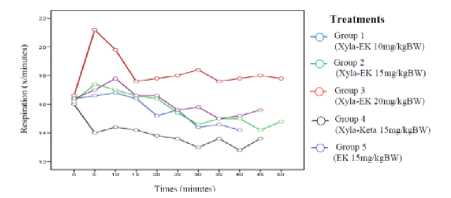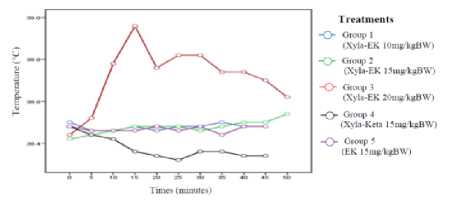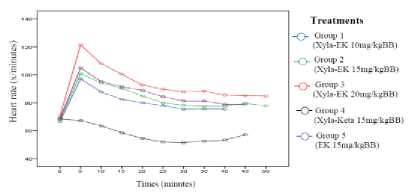The Effectivity of Ethanol Extract of Datura Metel L. Seeds as a General Anaesthesia on Kintamani Dogs
on
Veterinary Science and Medicine Journal, February 2016
Vol 4 No 1: 27-31
The Effectivity of Ethanol Extract of Datura Metel L. Seeds as a General Anaesthesia on Kintamani Dogs
I Putu Juli Sukariada1*, I Wayan Sudira2, I Gusti Ngurah Sudisma3 1Veterinary Surgeon in Denpasar, Bali 2Veterinary Pharmacology and Pharmacy Laboratory of Udayana University 3Veterinary Surgical and Radiology Laboratory of Udayana University *Corresponding author: jsukariada@gmail.com
ABSTRACT
This study aimed to determine the effectivity of ethanol extract of Datura metel L. seeds, as general anaesthesia on Kintamani dogs. A total of 25 dogs was divided into 5 groups, namely: group 1(treated by the combination of xylazin 1 mg/kg BW and ethanol extract of 10% Datura metel L. seeds 10 mg/kg BW), group 2 (treated by the combination of xylazin 1 mg/kg BW and ethanol extract of 10% Datura metel L. seeds 15 mg/kg BW), group 3 (treated by the combination of xylazin 1 mg/kg BW and ethanol extract of 10% Datura metel L. seeds 20 mg/kg BW), group 4 (treated by the combination of xylazin 1 mg/kg BW and ketamine 15 mg/kg BW), and group 5 (treated by the ethanol extract of 10% Datura metel L. seeds 15 mg/kg BW). Induction time, duration and recovery time were recorded, in which these responses were observed by clamping on the tail, ears and interdigital area. Physiological responses including respiration values, rectal temperature, oxygen saturation (SPO2), the frequency of the heart rate and electrocardiogram were observed using physiographic machine every 5 minutes until the dogs regain their consciousness. The level of ALT and AST was also examined to determine the level of toxicity of ethanol extracts of 10% Datura metel L. seeds. The results showed that group 1 and group 2 had no significant effect on the physiological response changes. However, the group 3 showed the sign of acute toxicity followed by increasing the levels of ALT and AST. The group 4 showed a decreasing physiological response, while group 5 had a similar response to group 2, but without sedation effect. It can be concluded that the ethanol extract of 10% Datura metel L. seeds has a potential as an analgesic and an anaesthetic agent.
Key words : general anaesthesia, ethanol extract of Datura metel L. seeds, Kintamani dog
INTRODUCTION
Anaesthesia is the most important stage in surgery. A good anaesthetic drug must meet an ideal criteria including sedation, analgesia and relaxation effects (Muir et al., 2000), and safe that it does not cause significant changes to the vital system. Nowadays the anaesthetic drugs are available with relatively expensive prices, therefore the researcher is working for new agents that could potentially be used as an alternative anaesthetic, one of them is Datura metel L. (Bbalola et al., 2014).
Datura metel L. contains the tropan alkaloid compounds namely, atropine, scopolamine and hyoscyamine. It is known as an anaesthetic for fishes (Herubawono, 2001). Atropine works by blocking reversibly the cholinomimetic action of the muscarinic receptors in the respiratory track to reduce the secretion of saliva, bronchial mucus and sweat (Bouzidi et al., 2011). The cardiovascular
system is biphasic in nature and in the gastrointestinal tract as an antispasmodic (Kato et al., 1972). Hyoscyamine can inhibit the gastrointestinal motility and reduce the gastric secretion (Moradi et al., 2015). Scopolamine is able to inhibit the release of acetylcholine on smooth muscle and depress the central nervous system (CNS) so as to give analgesic, sedation and relaxation effects (Bbalola et al., 2014).
This study aimed to examined the effectivity of the ethanol extract of 10 % Datura metel L. seeds, as an anaesthetic agent on Kintamani dogs and to determine the proper dose of the ethanol extract of 10% Datura metel L. seeds, as an anaesthetic agent.
MATERIALS AND METHODS
The research was conducted at the Veterinary Surgical and Radiology Laboratory, Veterinary Hospital, Faculty of Veterinary Medicine, Udayana University. The study used
25 Kintamani adult male dogs weighing 10-15 kg. They were divided into 5 groups, so that, each group consisted of five male dogs.
Each group was imposed with a different treatment. Group 1: treated by a combination of xylazin 1 mg/kg BW and ethanol extract of 10% Datura metel L. seeds, 10 mg/kg BW, group 2: treated by combination of xylazin 1 mg/kg BW and ethanol extract of 10% Datura metel L. seeds, 15 mg/kg BW, group 3: treated by a combination of xylazin 1 mg/kg BW and ethanol extract of 10% Datura metel L. seeds, 20 mg/kg BW, group 4: treated by a combination of xylazin 1 mg/kg BW and ketamine 15 mg/kg BW, and group 5: treated by an ethanol extract of 10% Datura metel L. seeds, 15 mg/kg BW. The substances were injected intramuscularly, then physiological responses of each treatment were observed using a physiographic machine and the anesthesia responses (induction time, duration, and recovery time) were recorded by clamping on tail, ears and interdigital area every 5 minutes. The level of ALT (SGPT) and AST (SGOT) was also examined to determine the grade of toxicity that can be caused by ethanol extracts of Datura metel L. seeds.
RESULTS AND DISCUSSION
Observations on response to anaesthesia showed that group 3 had the longest duration time, i.e 50.01 ± 0.02 minutes. This can happen because it is influenced by a large number of substances that enter the body of Kintamani dogs. Meanwhile, in group 5 the induction time, duration and recovery time were unobservable indicating that the induction of the ethanol extract of Datura metel L are less perfect (Figure 1).
Respiration rate in group 1 at minute -15th and -20th decreased, while in group 2 an increase of respiration rate occurred in minute-5th and started to go down from minute-10th until minute- 45th, and increase again in minute-50th until the dogs were conscious. The decrease and increase in respiration rate are still in the range of normal respiration rate and relatively stable (Figure 2).

Figure 1. Induction, Duration and Recovery time of Each Treatment on Kintamani Dogs.

Figure 2. The respiration Rate of The Kintamani
Dog in Each Group of Treatment.
In group 3 respiration rate has increased very extremely compared to other groups that occurred in minute 5. This is due to the effect of scopolamine within Datura metel L., which depresses the central nervous system at the medulla oblongata as the center of respiratory modulation (Flecknell, 1987).
There are chemoreceptors in medulla oblongata, that are sensitive to changes in the concentration of H+ ions and the concentration of CO2 pressure in blood. At the time of scopolamine reaches the medulla oblongata, there will be a stimulus to the chemoreceptors to perform a diffusion process, so that the concentration of H+ ions increases. The increase of the H+ ions concentration will stimulate the efferent neural activity that leads to the lung, causing the enlargement of alveolar ventilation and the increment of respiration rate (Kachny, 1983).
The respiration rate in group 4 decreased compared to other treatments. This is mediated by a working mechanism of ketamine as a noncompetitive antagonist of the N-methyl-D-aspartate receptor (NMDA receptor). The NMDA receptor is a glutamate receptor and ion channel protein found in nerve cells. The blockade of these receptors may impaire respiratory center and reduce the respiration rate (Engelhard et al., 1997).
Rectal temperature in groups 1, 2, and 5 showed a stable value compared to other treatments. This indicates that ethanol extract of 10% Datura metel L. seeds, at a dose of 10 mg/kg BW and 15 mg/kg BW do not give a tangible effect on the hypothalamus activity, so that there is no significantly change in term of rectal temperature. Group 3 showed a condition of hyperthermia. This condition is the effect of scopolamine and hyoscyamine in Datura metel L,which press M3 receptors in the hypothalamus and inhibit all the secretion and excretion of the body, so no heat release and the body is not able to function as a thermoregulator (William et al., 2008).

Figure 3. The Changes of rectal temperature during the administration of the treatments on Kintamani
dogs
Group 4 experienced hypothermia. This might occur due to exposure to cold temperatures for a long time, the inability to keep the heat and the inability to promote heatgenerating activities. It is also influenced by the effects of xylazin that are able to relax bronchial muscles, decrease the activity of the parasympathetic nervous system so that the release of acetylcholine from the nerve endings decreases, which makes the body is unable to function as a thermoregulator (Gunanti et al., 2011).

Figure 4. The change of oxygen saturation (SPO2) during the administration of treatments on Kintamani dogs
Oxygen saturation value of group 1, 2, 3 and 5 showed no significantly different from baseline for each treatment (P> 0.05), although there was an increase and a decrease in oxygen saturation at each treatment.
In group 4, oxygen saturation decreased sharply from the initial value and it was much lower than those of other treatments. A decrease in oxygen saturation is influenced by the effects of ketamine that leads to a reduction of alveolar tidal volume, resulting in the levels of oxygen entering the alveolar and then bind to hemoglobin reduce. In addition, the influence of xylazin on the sympathetic nervous system causes vasodilation of blood vessels that cardiac output (CO) decreases and lowers the level of blood oxygenation (Ismail et al., 2010) (Figure 4).
The frequency of heart rate in each treatment increased from the start of treatment, except in group 4 which was showed the decline of heart rate from the initial administration of anaesthetic agents (Figure 5). The highest heart rate was indicated in the group 3 with a value of 121.40 ± 2:19 x/min. This may associated with the scopolamine vagolytic action which can cause short tachycardia. Tachycardia arising from the effect of scopolamine can be referred to as supraventricular tachycardia (SVT) or Paroxysmal supraventricular tachycardia (PSVT) that is an abrupt disruption of the heart rate to become rapid. This situation is normal when it occurs briefly in animals that are under the influence of anaesthetic, heavy work, and atropine (Karim and Kabo, 2002).

Figure 5. The change of heart rate during the administration of the treatments on Kintamani dogs
In group 4, impaired heart rate occurred. It is influenced by xylazin which reduces sympathetic activity resulting the constriction of peripheral blood vessels, and decreasing the frequency of heart rate, cardiac output and peripheral blood pressure (Lumb and Jones, 1996).
The amplitude of the P wave and R wave, PR interval, QRS complex, and QT interval in each treatment showed no significant different values from baseline. This illustrates that each dose given on each treatment does not change the heart electricity in the event of depolarization and repolarization of atrium or ventricle. The heart muscle itself is able to
contract due to the flow of electricity from the sino-atrial node as a pace maker, atrioventricular node, the bundle of His and the Purkinje fibers. The nervous system can only modify the flow of electricity to the heart, so that changes in electric current or potential acts on the nervous system as a result of anesthesia treatment are unable to change the flow of electricity in the atria and ventricles of the heart (Sudisma et al., 2012).

Figure 6. ALT and AST enzyme levels during the administration of the treatments in Kintamani dogs
The value of liver function is measured by ALT (SGPT) and AST (SGOT) enzyme levels to determine the extent of liver damage resulting from the metabolism of ethanol extract of 10% Datura metel L. seeds. In groups 1, 2, 4, and 5 the values of ALT and AST were not significantly different from the normal value. However, in group 3 the values of ALT and AST levels increased much from the normal limit, that was 120.80 ± 1.92 UI/L and 110.20 ± 3.70 UI/L respectively (Figure 6).
High levels of ALT and AST indicate that there is a damage to the liver cells. The liver
cell damage releases intracellular enzymes into the bloodstream. Increased levels of ALT and AST also indicate an obstruction of the bile duct (Udem et al., 2009).
CONCLUSION
Ethanol extract of 10% Datura metel L. seeds is potential as a powerful and safe anaesthetic agent in Kintamani dogs. The use of ethanol extract of 10% Datura metel L. seeds at doses of 10-15 mg/kg BW does not affect the physiological response of Kintamani dogs.
ACKNOWLEDGEMENT
I would like to express thanks to the staff Diagnostic and Clinical Pathology, Faculty of Veterinary Medicine, Udayana University and the Kintamani kennel for supporting the research.
REFERENCES
Bbalola SA, Suleiman MM, Hassan AZ, Adawa DAY. 2014. Evaluation of the Crude Methanolic Seed Extract of Datura metel L. as a Potential Oral Anaesthetic in Dogs. Global Journal of Pharmacology 8 (2): 154-159
Bouzidi A, Mahdeb N, Kara N. 2011. Toxicity studies of alkaloids of seeds of Datura stramonium and synthesis alkaloids in male rats. Journal of Medicinal Plants Research Vol. 5(15), pp. 3421-3431
Engelhard K, Werner C, Lu H, Mollenberg O, Kochs E . 1997. Effect of S-(+)- ketamine on autoregulation of cerebral blood flow. Anasthesiol Intensivmed Notfallmed Schmerzther 32(12):721-5
Flecknell, P. 1987/Laboratory Animal Anaesthesia. London: Academic Press Limited.
Gunanti, Siswandi R, Soehartono RH, Ulum
MF, Sudisma IGN. 2011. The Anathesized of Pigs for Human Laparoscopy Model Using Zoletyl, Ketamine and Xylazine. Jurnal Veteriner. Vol. 12 No. 4: 247-253.
Herubawono N. 2001. Penggunaan Ekstrak Biji Kecubung (Datura metel) untuk
Penggangkutan Mas koki (Carassius auratus). Skripsi. Yogyakarta: Universitas Gajah Mada.
Kachny W. 1983. Respiratory acid-base disorders. Med. Clin. North Am. 67:914.
Karim S, Kabo P. 2002. EKG dan Penanggulangan Beberapa Penyakit Jantung untuk Dokter Umum. Jakarta: Balai Penerbit FKUI. 217 hlm.
Kato G, Tan E, Yung J. 1972. Acetylcholinesterase: Kinetic Studies on the Mechanism of Atropin Inhibition. Canada: The Journal of Biological
Chemistry Vol. 10, 28, pp. 3186- 3189.
Lumb WV, Jones EW. 1984. Veterinary Anesthesia. Philadelphia: Lea and
Febiger.
Moradi B, Delpan B, Hashemi P, Mousavi A, Rahmana H. 2015. Matrix Solid Phase Dispersion Extraction for Tropane
Alkaloid Detection in Cultured and
Collected Hyoscyamus reticulates Plants. International Journal of Advanced Research. Volume 3, pp. 78-82.
Muir WW, Hubbell JAE, Skarda RT, Bednarski RM. 2000. Veterinary Anesthesia. Ed. ke-3. United States of Amerika: Mosby.
Sudisma IGN, Widodo S, Sajuthi D, Soehartono H. 2012. The Gravimetric Infusion Anaesthesia with Ketamine and Propofol in Dogs. Jurnal Veteriner. Vol.13 No.2: 189-198.
Udem SC, Obidoa O, Asuzu IU. 2009. Acute and Chronic Toxicity Studies of Erythrina senegalensis DC Stem Bark Extract in Mice. Comp. Clin. Pathol., 19:75-282.
William P, Cheshire Jr, Robert DF. 2008. Drug-Induced Hyperhidrosis and Hypohidrosis. Drug Safety : 31(2): 116117.
31
Discussion and feedback